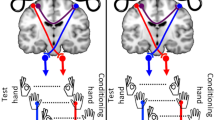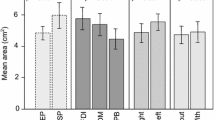Abstract
The efficacy of inhibitory and excitatory intracortical circuits acting on the representation of an intrinsic hand muscle in the primary motor cortex of both hemispheres was measured with paired transcranial magnetic stimuli in right-handed subjects. Both intracortical inhibition (measured with an interstimulus interval of 3 ms) and intracortical facilitation (measured with an interstimulus interval of 16 ms) developed more rapidly with increasing conditioning stimulus intensity in the dominant than the non-dominant hand. We conclude that the intracortical circuits in the primary motor cortex are more potent in the dominant than the non-dominant hemisphere, and hypothesize that this difference is a factor in the asymmetrical dexterity associated with hand preference.


Similar content being viewed by others
References
Amunts K, Schlaug G, Schleicher A, Steinmetz H, Dabringhaus A, Roland PE, Zilles K (1996) Asymmetry in the human motor cortex and handedness. Neuroimage 4:216–222
Amunts K, Schmidt-Passos F, Schleicher A, Zilles K (1997) Postnatal development of interhemispheric asymmetry in the cytoarchitecture of human area 4. Anat Embryol 196:393–402
Bennett KM, Lemon RN (1996) Corticomotoneuronal contribution to the fractionation of muscle activity during precision grip in the monkey. J Neurophysiol 75:1826–1842
Cicinelli P, Traversa R, Bassi A, Scivoletto G, Rossini PM (1997) Interhemispheric differences of hand muscle representation in human motor cortex. Muscle Nerve 20:535–542
Civardi C, Cavalli A, Naldi P, Varrasi C, Cantello R (2000) Hemispheric asymmetries of cortico-cortical connections in human hand motor areas. Clin Neurophysiol 111:624–629
Di Lazzaro V, Restuccia D, Oliviero A, Profice P, Ferrara L, Insola A, Mazzone P, Tonali P, Rothwell JC (1998) Magnetic transcranial stimulation at intensities below active motor threshold activates intracortical inhibitory circuits. Exp Brain Res 119:265–268
Foundas AL, Hong K, Leonard CM, Heilman KM (1998) Hand preference and magnetic resonance imaging asymmetries of the central sulcus. Neuropsychiatry Neuropsychol Behav Neurol 11:65–71
Fuhr P, Agostino R, Hallett M (1991) Spinal motor neuron excitability during the silent period after cortical stimulation. Electroencephalogr Clin Neurophysiol 81:257–262
Hammond G (2002) Correlates of human handedness in primary motor cortex: a review and hypothesis. Neurosci Biobehav Rev 26:285–292
Henkel V, Mergl R, Juckel G, Rujescu D, Mavrogiorgou P, Giegling I, Moller H, Hegerl U (2001) Assessment of handedness using a digitizing tablet: a new method. Neuropsychologia 39:1158–1166
Hore J, Watts S, Tweed D, Miller B (1996) Overarm throws with the nondominant arm: kinematics of accuracy. J Neurophysiol 76:3693–3704
Huntley GW, Jones EG (1991) Relationship of intrinsic connections to forelimb movement representations in monkey motor cortex: a correlative anatomic and physiological study. J Neurophysiol 66:390–413
Inghilleri M, Berardelli A, Cruccu G, Manfredi M (1993) Silent period evoked by transcranial stimulation of the human cortex and cervicomedullary junction. J Physiol 466:521–534
Keller A (1993) Intrinsic synaptic organization of the motor cortex [review]. Cereb Cortex 3:430–441
Kujirai T, Caramia MD, Rothwell JC, Day BL, Thompson PD, Ferbert A, Wroe S, Asselman P, Marsden CD (1993) Corticocortical inhibition in human motor cortex. J Physiol 471:501–519
Oldfield RC (1971) The assessment and analysis of handedness: the Edinburgh inventory. Neuropsychologia 9:97–113
Parlow S (1978) Differential finger movements and hand preference. Cortex 14:608–611
Peters M (1980) Why the preferred hand taps more quickly than the non-preferred hand: three experiments on handedness. Can J Psychol 34:62–71
Phillips JG, Gallucci RM, Bradshaw JL (1999) Functional asymmetries in the quality of handwriting movements: a kinematic analysis. Neuropsychology 13:291–297
Porter R, Lemon R (1993) Corticospinal function and voluntary movement. Clarendon Press, Oxford
Priori A, Oliviero A, Donati E, Callea L, Bertolasi L, Rothwell JC (1999) Human handedness and asymmetry of the motor cortical silent period. Exp Brain Res 128:390–396
Ridding MC, Sheean G, Rothwell JC, Inzelberg R, Kujirai T (1995) Changes in the balance between motor cortical excitation and inhibition in focal, task specific dystonia. J Neurol Neurosurg Psychiatry 59:493–498
Reilly KT, Hammond GR (2000) Independence of force production by digits of the human hand. Neurosci Lett 290:53–56
Sainburg RL (2002) Evidence for a dynamic-dominance hypothesis of handedness. Exp Brain Res 142:241–258
Schieber MH (2001) Constraints on somatotopic organization in the primary motor cortex. J Neurophysiol 86:2125–2143
Semmler JG, Nordstrom MA (1998) Hemispheric differences in motor cortex excitability during a simple index finger abduction task in humans. J Neurophysiol 79:1246–1254
Todor JI, Smiley-Oyen AL (1987) Force modulation as a source of hand differences in rapid finger tapping. Acta Psychol 65:65–73
Werhahn KJ, Kunesch E, Noachtar S, Benecke R, Classen J (1999) Differential effects on motorcortical inhibition induced by blockade of GABA uptake in humans. J Physiol 517:591–597
Ziemann U (1999) Intracortical inhibition and facilitation in the conventional paired TMS paradigm. Electroencephalogr Clin Neurophysiol Suppl 51:127–136
Author information
Authors and Affiliations
Corresponding author
Rights and permissions
About this article
Cite this article
Hammond, G., Faulkner, D., Byrnes, M. et al. Transcranial magnetic stimulation reveals asymmetrical efficacy of intracortical circuits in primary motor cortex. Exp Brain Res 155, 19–23 (2004). https://doi.org/10.1007/s00221-003-1696-x
Received:
Accepted:
Published:
Issue Date:
DOI: https://doi.org/10.1007/s00221-003-1696-x




